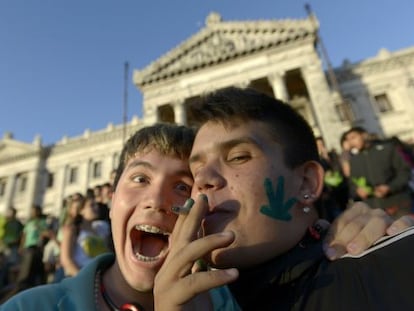Harvest time begins at Latin America’s largest marijuana farm
The pioneering plantation in southern Chile produces about 1.5 tons a year for medical use

Latin America's largest farm growing marijuana for medical use, located in southern Chile, has begun its harvest. Sponsored by the Daya Foundation, a not-for-profit organization dedicated to alleviating human suffering, it hopes to pick 1.5 tons of the plant by mid-April.
“If you think that to make a joint, you use half a gram, we have enough to make three million joints,” jokes Pablo Meléndez, director of operations. “With one for every six people, that's enough for the whole of Chile.”
Meléndez oversees the progress of the 6,400 plants seeded last November in this field in Quinamávida, 320 kilometers south of the Chilean capital of Santiago.
“It’s an unprecedented initiative in the region,” says Daya's Ana María Gazmuri, who is supervising the project. “Despite not having the most advanced legislation, Chile is a pioneer among Latin American countries,” she adds.
The medicines produced from the marijuana will be used to treat around 4,000 patients suffering from chronic pain
Uruguay is the only country in the world that has fully legalized marijuana.
With no airports nearby, accessing the farm is not easy. From Santiago, it’s a 300-kilometer drive south to the city of Linares. From there, the road twists and turns, requiring several phone calls to the hosts for directions.
The smell from several meters away is intense. The entrance leads up to a steep dirt road and sentry box where a guard asks for visitors’ details. Finally, the crop comes into view: one hectare of marijuana plants perfectly lined up waiting to be harvested.
The Daya Foundation cultivates 16 varieties of marijuana and has established several security measures to prevent theft: guards patrol 24 hours a day, and there is an electrified fence, a dog, security cameras and direct lines to two police stations in the area. “But we've found there is a certain level of social awareness when it comes to plantations for the sick,” says Gazmuri.
Homemade marijuana-based medicines
Until last year, marijuana-based medicines could only be purchased on the black market in Chile. To help people suffering from chronic pain, three years ago, the Daya Foundation set up a medical network to teach patients who opted for this kind of therapy how to make their own medicines. Now, about 700 people are using homemade cannabis-based treatments. “It changed my life,” says Arturo who suffers from a degenerative disease that put him in a wheelchair. He is now able to lead an independent life and regularly takes 100-kilometer bike trips.
Around 60 locals have been hired to help with the harvest and kitted out with protective suits and gloves. They cut, wash, and then hang the plants in drying sheds. They are then ground up and analyzed by Chilean pharmaceutical company Knop Laboratorios. “It will be the first plant-based medicine made from cannabis produced in Latin America,” says Nicolás Dormal, the farm’s director.
About 20 Chilean municipalities have financed the project. The medicines produced from the marijuana will be used to treat around 4,000 patients suffering from cancer, epilepsy and the chronic pain caused by arthritis and multiple sclerosis.
Representatives from Argentina and Brazil regularly liaise with Daya to study its production and management model. “People also come from Australia and California and are dumbstruck by what they discover,” Gazmuri explains, adding that marijuana cultivation for medical use is set to “take off” in Latin America. “Colombia has just legalized medical use, Costa Rica is trying, Uruguay just began its first production.”
Chilean law does not ban cultivation or consumption of marijuana, but selling the drug is illegal. “There was the mentality here that we couldn't do this. Many conservative sectors of Chilean society should be asking themselves how we were able to score this important goal,” Gazmuri says.
English version by Dyane Jean François
Tu suscripción se está usando en otro dispositivo
¿Quieres añadir otro usuario a tu suscripción?
Si continúas leyendo en este dispositivo, no se podrá leer en el otro.
FlechaTu suscripción se está usando en otro dispositivo y solo puedes acceder a EL PAÍS desde un dispositivo a la vez.
Si quieres compartir tu cuenta, cambia tu suscripción a la modalidad Premium, así podrás añadir otro usuario. Cada uno accederá con su propia cuenta de email, lo que os permitirá personalizar vuestra experiencia en EL PAÍS.
¿Tienes una suscripción de empresa? Accede aquí para contratar más cuentas.
En el caso de no saber quién está usando tu cuenta, te recomendamos cambiar tu contraseña aquí.
Si decides continuar compartiendo tu cuenta, este mensaje se mostrará en tu dispositivo y en el de la otra persona que está usando tu cuenta de forma indefinida, afectando a tu experiencia de lectura. Puedes consultar aquí los términos y condiciones de la suscripción digital.
More information
Últimas noticias
Most viewed
- Pablo Escobar’s hippos: A serious environmental problem, 40 years on
- Reinhard Genzel, Nobel laureate in physics: ‘One-minute videos will never give you the truth’
- Why we lost the habit of sleeping in two segments and how that changed our sense of time
- Charles Dubouloz, mountaineering star, retires at 36 with a farewell tour inspired by Walter Bonatti
- The Florida Keys tourist paradise is besieged by immigration agents: ‘We’ve never seen anything like this’











































